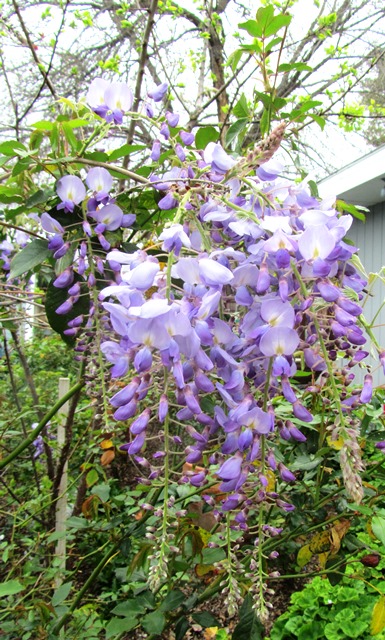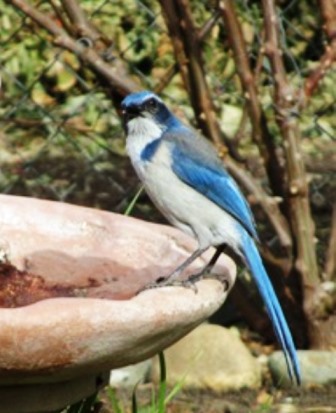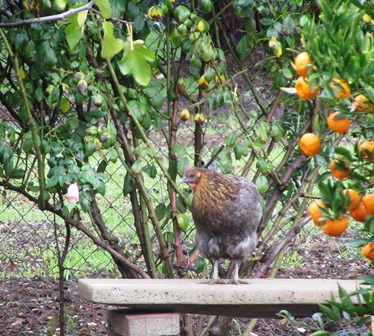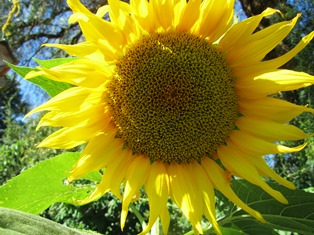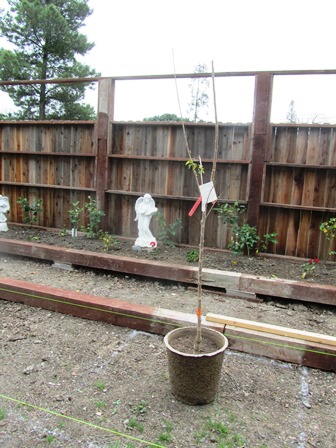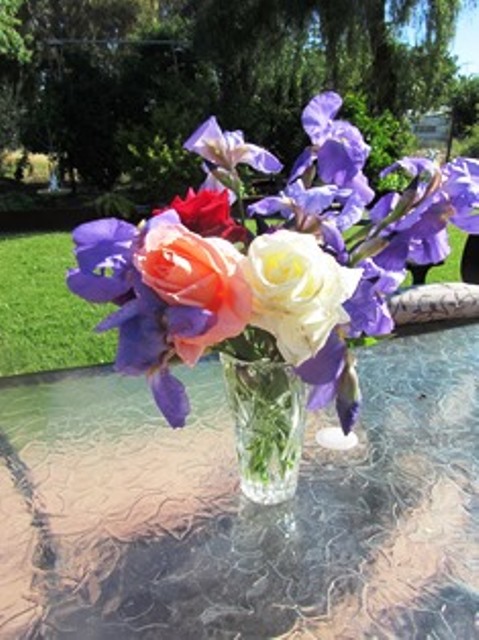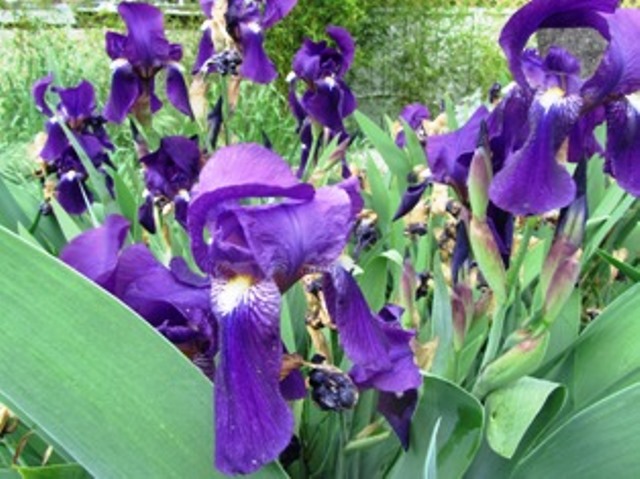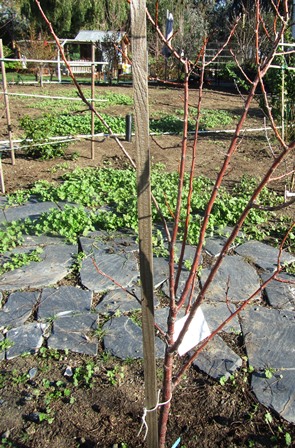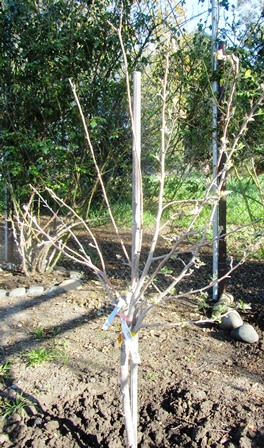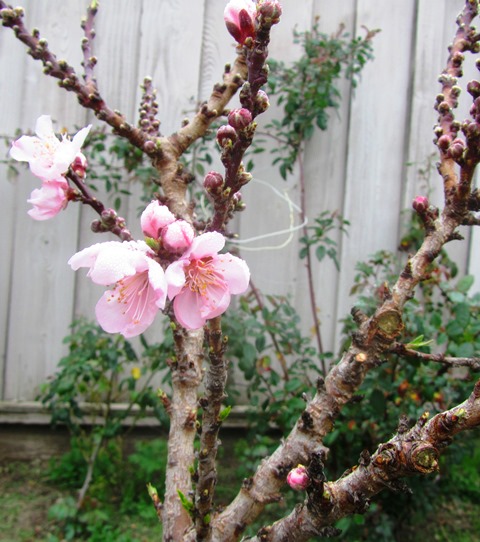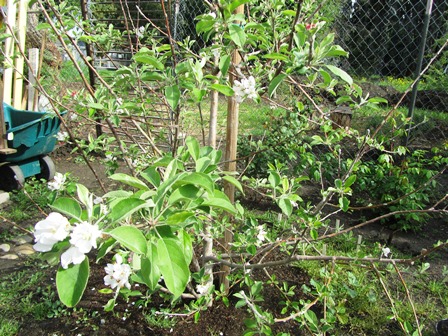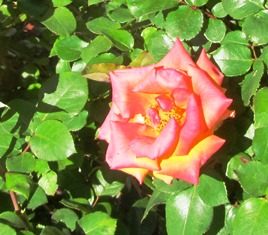Archive for the 'Gardening' Category
Flowers, Nest-Building, and Bee Swarms . . . Spring Has Arrived
The wisteria hangs in long purple bracts, its color finding resonance in the grape hyacinth blooms and the lavender buds. Delicate blossoms of pink and white create canopies of color for the fruit trees, and birdsong fills the air. Spring brings its gifts.
As the blue jay creates a screeching racket to the mockingbird’s ready song, the white-crowned sparrows have taken up residence in a row of birdhouses we’ve placed high on the back fence.The entrances of the sparrow houses are too small for the jay to access; a good thing since jays have earned a reputation as nest robbers.
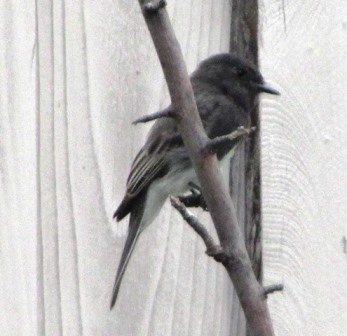
Crew Cut, our resident black phoebe, nests under an eve of the old chicken house; the male teaches its young to catch insects on the wing
Yesterday, I spotted the black phoebe pulling a piece of coir from a wall planter for its nest. These peaceful birds make a sound of tsip or fi-bee, fi-bee and can rise to roughly 50 feet to sing to a female.They range from California to central Texas, and even venture all the way to Argentina.
In the tallest eucalyptus on the acre that stands vacant behind our property, a pair of hawks are also nest-building. My farmette lies in their flight path. Not a good thing to see–hawks swooping down over my chickens and then rising to their lofty nest.
I threw some wildflower seed in beds over the weekend and then, after spotting my neighbor’s errant hen who flew to our yard, I began to regret my action. What can I do now but hope that she’ll not devour the seeds with her constant hunting and pecking?
Last night, I could have sworn I heard the pitter-patter of raindrops against the stone patio floor. With a steaming mug of coffee in hand at four o’clock this morning, I ventured outside and sure enough . . . it was still sprinkling. Hooray! It’s our first spring shower!
So, with all the nest-building and Mother Nature dropping a shower upon us, I know the wildflowers are blooming, too. That means the honeybee season is upon us. My neighbor has already had a bee swarm. I’m not ready, but I can’t stop Mother Nature from beginning a new cycle of seasons just because I don’t yet have my new honey frames assembled. That’s not how it works. Ready or not, spring has arrived.
Giant Sunflowers Provide Food and Fun for Everyone
Giant sunflowers need space to grow to full size; they can reach six or more feet tall. Bees love them for their pollen. Kids love them when the foliage of the plants create a secret fort or a fairy circle. Humans, birds, and squirrels love them for their seeds.
For best results, plant giant sunflowers at the back of a garden. They need good soil and full sun. Plant when the danger of frost has past. A rule of thumb to follow is to plant them about one inch deep and six inches apart. While the seeds are germinating, keep the soil moist.
Later on, when the plants stand about three inches tall, you can begin to thin them. Leave about one foot between each plant. This can enable a strong root system for form. The stalks will become sturdy and measure about three to four inches in circumference when fully grown.
First come the gorgeous petals in green to yellow and then bright yellow. As the bees pollinate the florets and they drop, the seeds will mature. Seeds are either gray or brown in color.
I always cut the heads when the seeds are plump, firm, and begin to drop. I let the heads dry well in the sun for days before I remove the seeds. Fully dry seeds can be stored in containers for human consumption or to be fed to the squirrels and birds.
* * *
If you enjoy reading about farmette topics (including gardening, beekeeping, and delicious recipes), check out my cozy mysteries A BEELINE TO MURDER and also THE MURDER OF A QUEEN BEE in the Henny Penny Farmette series (from Kensington Publishing).
These novels are available through online retailers such as Amazon, Barnes & Noble, Kobo Books, and Walmart as well as from traditional bookstores everywhere.
See, http://tinyurl.com/hxy3s8q
Now available in mass market paperback, this debut novel launched the Henny Penny Farmette series of mysteries and sold out its first press run.
See, http://tinyurl.com/h4kou4g
The second cozy mystery in the Henny Penny Farmette series, available Sept. 27, 2016
The Start of Something Wonderful . . . Spring!
I jumped at the chance to visit my favorite nursery this past weekend after my husband suggested a drive to Livermore, California. Alden Lane Nursery occupies a beautiful setting amid ancient oaks and there is even a honeybee hive on the premises. Wisteria blooms in perfusion there this time of year.
We came away with some pepper plants, two smoke trees, and four cherry trees, including Bing and Black Tartarian, its pollinator.
We are going to plant the cherry trees at the front of our property and the smoke trees will go in that area as well. We’ve done very little landscaping on the front of our land, preferring to get the trees and gardens in at the back near our hives and chicken run.
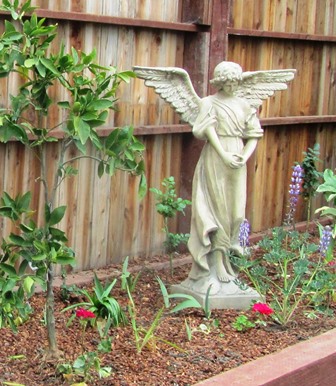
The beds that run the length of the fencing at the front of the farmette feature statuary, citrus, and bedding plants
Everywhere you look on the farmette, there are projects to be done. We chip away at them when we can. My husband works days and I write my novels, so the work will undoubtedly be never-ending. But that’s okay. We aren’t in a hurry and it’s easier to just live by the cycles and seasons of nature.
When I think of how the peaches and apricots are forming and the bees are almost ready to swarm, I know spring is here. And it’s my favorite season, so I’ll go outside, ignore the projects, have a cup of tea, and enjoy the start of something wonderful!
What Could Be Easier than Growing Irises in Raised Beds?
When we first moved to the Bay Area from Miami, the heirs to the property behind ours gave us some bearded irises that had been planted in the 1950s by their parents. I recall the beauty of irises on my grandmother’s farm in Missouri. She called them flags.
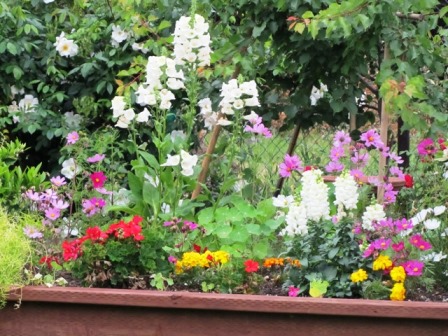
For a lovely raised flower bed, plant other bloomers like cosmos, geraniums, pansies, nasturtiums, and marigolds with iris cultivars
Mostly colored in deep purples and blues, white, and pinkish-beige, the bearded irises have added an aesthetic appeal to our farmette that was mostly just a big field with a tiny house in the middle. We’ve planted them in the ground, along fences, and in raised boxes.
Easy to grow and maintain, the irises have become one of our favorite flowers. We’ve kept them going in our garden and they’ve rewarded us with many new rhizomes.
As we’ve continued to restore the farmette, we’ve built many four by six feet boxes for raised beds. The materials cost roughly $125 per box. We like them because we can easily control the soil (building it up with compost, manure, and other amendments), drainage, tilling, and weeds. Recently we decided to make irises the mainstay of a raised bed border.
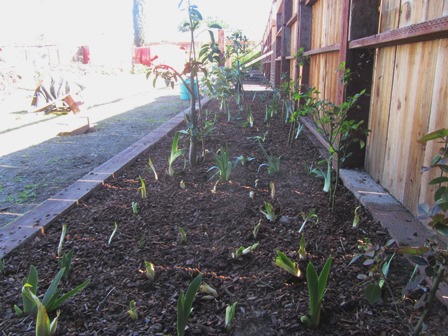
We’ve interplanted citrus and bearded irises in this raised bed spanning the length of the front fence
Over the weekend, we built a long raised bed that extends the entire length of the fencing on the southwestern side of our property. In it, we planted lots of citrus trees, climbing roses, and irises. If you are thinking of doing something comparable, have fun choosing from among the hundreds of cultivars of bearded and Siberian irises.
Plant them about three inches deep and a few inches apart in well drained, fertile soil. Irises need shade from the hottest sun and enjoy a deep drink of water, especially during blooming. I enjoy the ease of growing them in raised beds and love, love, love the magnificent color atop tall stalks when they bloom.
Early Bird Tips for Bare-root Fruit Trees
Gardeners understand that appearances can be deceiving. For example, during bare-root season (starting now in the Bay Area), twiggy fruit trees with no leaves are becoming plentiful offerings in local nurseries.
Bare-root trees are so-called because their roots are bare and packed in moist sawdust inside a burlap wrap. This makes it easy for the gardener to estimate the size of the planting hole (make the hole twice as deep and wide as the tree’s roots).
Plant two or three bare-root trees (select those that will pollinate each other for best results) in a single hole if space is a consideration. This is called high-density planting.
Consider a multi-grafted tree if you desire several types of fruit. Because the grafted trees use a basic tree and graft on scions of other varieties (often the same type of fruit such as apples), some branches will blossom and leaf out before others.
Another space saver in the garden is the espaliered tree. Choose a sunny place against a trellis, fence, or wall to train your tree, using wires for support. You will be directing its limbs to grow in a horizontal pattern.
All plants need water and food. During the winter, you may need very little water but in spring and summer check the soil often and when it’s dry down two inches, be sure and water your plant.
Fertilize your trees three times each year: after blossoming, after fruiting, and in the fall.
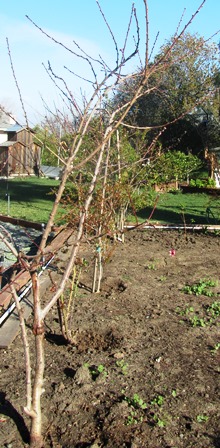
Planted in a row along a gravel path is a peach, a tea rose bush, an apricot, and a pomegranate tree
Prune your fruit trees in early winter, when the tree is dormant. With these early bird tips, your bare-root trees will get off to a great start.
Blooms over the Garden Gate
The nectarine trees are susceptible to Peach Leaf Curl and usually, I try to spray them three times before the next year’s blooms. Alas, this year, I didn’t complete the task before the tree broke bud.
Elsewhere, the almonds, apricots, and apples are blooming. So are some of the roses–Lady Banks, for example. Also, Fiesta and the beautiful Iceberg rose in the front of our house.
My neighbor’s two almond trees are covered in blooms of white blossoms. Last Friday, when I contacted a local beekeeper business, I was told they were closed to move their hives of bees out to pollinate the almond orchards. Farmers pay the beekeepers for “renting” those hives of industrious little bees for the job of pollinating their crops.
This is supposedly “bare root” season, but the warm weather coupled with the rain we had in December seems to have brought us an early spring. If you look over my garden gate, you will see signs of it everywhere.
Tis the time for Cool Season Planting
If you love the cool season plants like lettuce, spinach, kale, onions, leeks, sugar snap peas, and artichokes, Valentine’s Day weekend is the time to start planting cool season crops in the Bay Area and other warmer climates.
I put in onions throughout the cool season and am rewarded with burlap bags of red onions, yellow, white, and the walla walla variety for kitchen soups and other culinary creations during the first months of the year.
My husband is building more growing boxes (4 x 4 x 3) in which we shovel amended soil, some planting mix, bone meal, blood meal, compost, and chicken manure. The soil will grow almost anything.
This weekend, we’re moving a couple of citrus trees and three rose bushes. I’ll feed and water and watch for the new shoots to show within a week or two if the weather stays warm. So, you see, Valentine’s Day isn’t just for lovers but also people who love to garden.
Working the Beds after the Weekend Storm
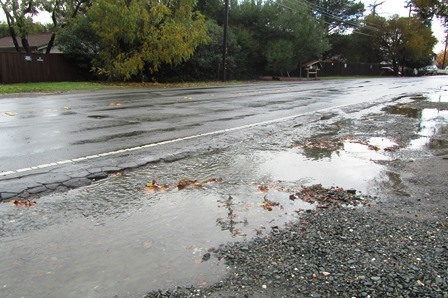
A “Pineapple Express” rainstorm with gale-force winds blew out the power and made for slick roads as well as ponds in our clay soil
The weekend storm is still a vivid memory, what with the fence along one side of my property beaten down by high winds and pounding rain that also brought a power outage on Friday night.
But today with outside temperatures in the 70s Fahrenheit, I cleaned my strawberry beds. Somehow, mint had crept in and I don’t want mint with my berries although I like it served that way for dessert.
My neighbor’s relative, who’s visiting from Lebanon where they grow apples in his mountain village, share a suggestion for digging dried chicken manure around the bases of my trees. The high nitrogen will get them off to a great start and my trees have already broken bud (which is attracting the honeybees).
The wild bird population seems to have exploded and I see signs of nest building starting. The five suet cakes I hung in trees for the songbirds, blue jays, and woodpeckers last month are down to a fraction of their original size.
I extended the chicken run with poultry wire high enough to keep the my heritage girls from flying out. Now, they’ll have plenty of space on both sides of the chicken house to forage and out the beds I’m working.
Creating Functional Space in Our Small Farmhouse Kitchen
“There’s never enough storage space!” It’s become a lament I want to banish from my frequent utterances.

Our farmhouse kitchen counter and cabinets during early renovation. Carlos cut the sunburst pattern from blue-black granite
At roughly 1,000 square feet, our house isn’t terribly small by the 1970’s standard when the average American home was 1,400 square feet. And by the 195o’s standard of 983 square feet, my house is positively roomy. However, today, the average American house footprint stands at 2,598 square feet. That said, there is a tiny house movement on and that’s a good thing for the environment.
Having lived in larger houses, I can honestly say I love this smaller home. The costs for energy, upkeep, homeowner’s insurance, and property taxes are considerably less. The need for interior furnishings shrinks, too.
The downside is there is less space for storage. We have had to maximize our options. I keep bees and beekeeper supplies like honey jars and lids as well as my cases of jam jars and lids and the final, finished products have to be stored somewhere. And then there are my cookbooks (I’ve cut the collection from over a hundred to a quarter of that).
My designer/architect husband Carlos Carvajal came to my rescue by carving out some space for bookcase in the wall between the kitchen and the bar area.
He also took space from the kitchen to create a laundry area with washer and dryer and hid them behind bi-fold doors.
The bar area has a bank of lower cabinets that can hold glassware, appetizer dishes, and serving platters. He re-created a new cabinet unit from a bank of old upper kitchen cabinets, mounting them on the wall above the granite counter-top with an inset sink.
A narrow moveable butcher block cart on wheels with a couple of shelves could give me a little extra storage, if we could find one that would fit in the limited space near the oven.
I think we’ve maximized our storage options in the kitchen and created a highly functional space so maybe I can now abandon that lament.
Speaking of Roses
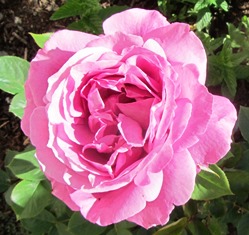
This candy-stripe rose was a gift from a friend–a cutting from her rose that became a large bush in my garden
If you love roses like I do, you probably already have a few growing in your garden. Perhaps you also look forward during long winter evenings to perusing the offerings in the catalogs of rose growers and dreaming of new varieties to plant in the spring.
Whether you are new to growing roses or have been gardening with them for a while, a review of types and species might be in order, especially before you plan a visit to your local gardening center. Bare root roses will start arriving in about three weeks here in Northern California.
TYPES OF ROSES
Roses fall roughly into four general categories: Bush Roses (this is the largest group and includes hybrid tea, polyantha, floribunda, heritage or old rose, miniature, and tree roses), Climbing Roses (large-flowering climbers have canes to 10 feet, ramblers have canes to 20+ feet and small flowers in early summer), Shrub Roses (upright growth habit reaches 4 to 12 feet and may only bloom once during summer), Groundcover Roses (also called carpet roses, these grown in low mounds and can bloom only once or repeatedly).
SPECIES of ROSES
Alba–These beauties are white or palest pink with gray-green foliage.
Bourbon–Repeat bloomers that have a wide height range and glossy green foliage.
Centifolia–These stunning beauties were favored by the Dutch master painters. Centifolia roses contain many petals on cold-hardy plants that grow 4 to 8 feet tall.
Climbers–These roses come in a wide variety of bloom type and color and have long, arching canes.
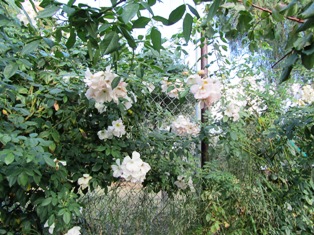
Climbing Sally Holmes produces large sprays of white to palest pink roses along the back fence of our property, from early spring to frost
Damask–May bloom only once although some varieties will repeat; the flowers are white or soft pink and fragrant. For centuries, this was the rose species used to produce Attar of Roses.
Florabunda–Produces sprays of roses and is a repeat bloomer.
Grandiflora–Similar to hybrid tea roses, the grandiflora blooms on long canes and is associated with the high-centered blooms so often seen in floral shops.
Hybrid Gallica–An old rose that blooms in the spring; flowers are pink or red or even striped and emerge on plants that stand about 4 feet tall.
Hybrid Perpetual–These roses were especially loved in the 1800’s for their red and pink color, repeat flowering, and height of six feet.
Hybrid Tea–Blooms on long canes as a single bloom or sprays of flowers.
Polyantha–Smaller blooms than the florabundas but can produce large sprays in repeated flowering.
Noisette–Plants tend to be large and often sprawl but can produce fragrant clusters of blooms and are repeat-flowering. They are sensitive to cold and frost.
Miniature–Small roses ranging in height from 1 to 3 feet with miniature flowers and foliage.
Shrub–Hybrid rugosas are an example of the shrub varieties (of which there are many). Often these roses have lots of prickles.
Tea Roses–These plants have quite large blooms, but the drawbacks include weak canes and a susceptibility to frost and cold. Their height and bloom color can vary widely.
 Facebook
Facebook Goodreads
Goodreads LinkedIn
LinkedIn Meera Lester
Meera Lester Twitter
Twitter




